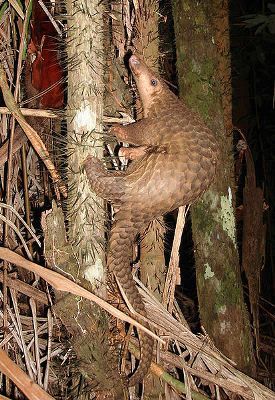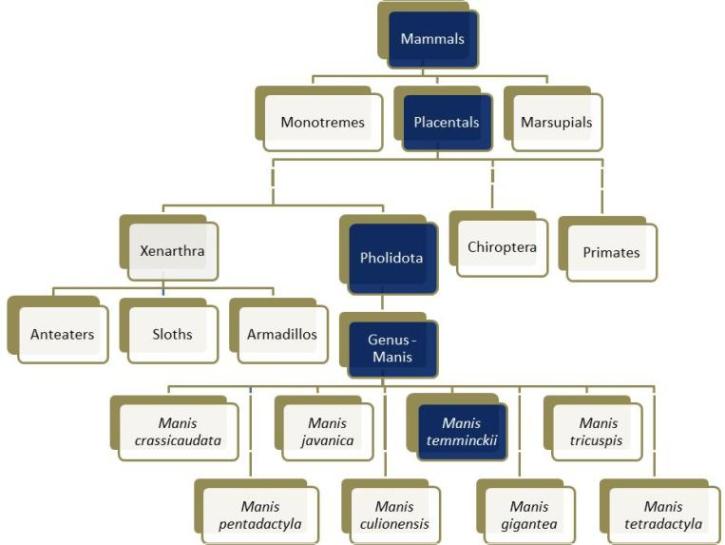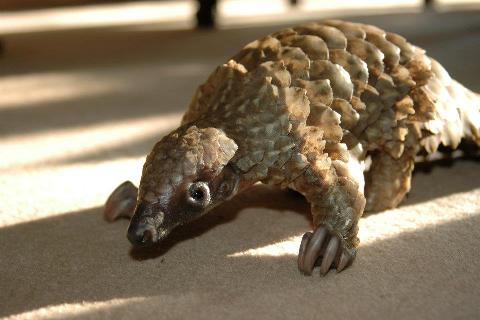Taxonomy and Classification
- How did it get its name?
Strangely, this particular species can be referred to by two scientific names: Manis temminckii and Smustia temminckii. The genus Smutsia is usually only a subgenus, however for this particular species and Smutsia gigantea, it can be considered a genus. For this website, I will be referring to the species as Manis temminckii, the way it is most commonly classified. The genus name Manis means hand in English because of the strong hands all pangolins have for digging. The specific epithet temminckii is named after a Dutch zoologist - Coenraad Jacob Temminck, who is pictured below.
This organism also has several different common names: the ground pangolin, the cape pangolin, and Temminck's pangolin. The ground pangolin got its common name "pangolin" from the Malay world "pengguling," meaning rolling up. This is because when threatened, the animal has the ability to roll into a tight, almost impenetrable ball.
The following is the specific taxonomy for Manis temminckii :
Domain: Eukarya
Kingdom: Anamalia
Phylum: Chordata
Class:
Mammalia
Order: Pholidota
Family: Manidae
Genus: Manis
Species: Manis temminckii
Domain: Eukarya
The ground pangolin is a member of the Eukarya because it has a true
nucleus, linear DNA, and membrane bound organelles, characteristics that all
eukaryotes exhibit.
Kingdom: Animalia
Organisms in this kingdom are multicellular, heterotrophic - consuming other
organisms for food, and are able to move, all traits which pangolins also
have.
Phylum: Chordata
Like all other chordates, Manis temminckii possesses a notochord, a
dorsal, tubular nerve chord, pharyngeal gill slits, an endostyle, and a
postanal tail at some point in their life cycle. This species also
belongs to the Subphylum Craniata.
Class: Mammalia
Characteristics of animals in the Mammalia include a body covered with
keratinous hair (the scales of the pangolin are actually fused hairs), mammary
glands that produce milk for young. Mammals also are endothermic and
have highly developed parental care. Ground pangolins are also
classified under the Infraclass Eutheria, meaning they are Placentals and
have a long time of gestation, giving birth to highly developed young.
Order: Pholidota

The Pholidota is made of different species of pangolins.
All members share characteristics such as scales covering their bodies, no
teeth, and very long tongues. Another pangolin species, Manis
javanica, is pictured to
the right.
Family: Manidae
Only 8 species of pangolins comprise this particular family. These
species include the giant pangolin, tree pangolin, long-tailed pangolin,
Chinese pangolin, Indian pangolin, Malayan pangolin, Philippine pangolin,
and of course, the ground pangolin. All pangolins have long claws, the
ability to curl into a ball, and are primarily nocturnal.
Genus: Manis
The genus Manis contains the same 8 species that are found in the Manidae
family. Other characteristics the species of pangolins posses
are a long tail, thick eyelids, and a gizzard - like stomach. Four
species (Chinese, Indian, Malayan and Philippine) reside in Asia
while the
others (tree, giant, long-tailed, and ground) can be found in Africa.
The ground pangolin is different in a few ways from other pangolin
species. Unlike some pangolins, Manis temminckii is unable to
climb, has a smaller head than other species, and lives in Central and
Southern Africa.

This phylogenetic tree diagrams the domains to the
subclasses to which Manis temminckii is most closely related.
It is based solely on morphology, or physical characteristics. More
specifically, the absence of a cell wall separates the Animalia from the
Plantae and Fungi, the presence of a skull distinguishes the Craniata from
the Cephalochordata and Urochordata, and internal development of young that
are well developed at birth defines the Mammals and Placentals. The
blue parts of the tree indicate the taxa to which Manis temminckii
belongs.

This phylogentic tree shows the taxa from class to species
in which the ground pangolin can be found as well as other closely related
taxa. Like the first tree, this one is also based on morphological
characteristics. Some of the characteristics that were used are
explained in the following sentences. Placentals give birth to live, mature
young, making them different from Monotremes and Marsupials. Members
of the Pholidota and Xenarthra do not have teeth, making them more closely
related than species of the Chiroptera and Primates. However, the
Pholidota posses tough scales, which the Xenarthra do not have. Within
the Order Pholidota, there is only one Genus, Manis. This genus
includes all 8 extant pangolin species that are living
today. Manis temminckii, the focus of this website, is
different than other pangolin species in this genus because
it possesses a short tail, a smaller head, and larger scales. Again, the blue sections are
taxonomic categories to which the ground pangolin
belongs.
Click here to check out where the ground pangolin lives!
Back to Homepage

